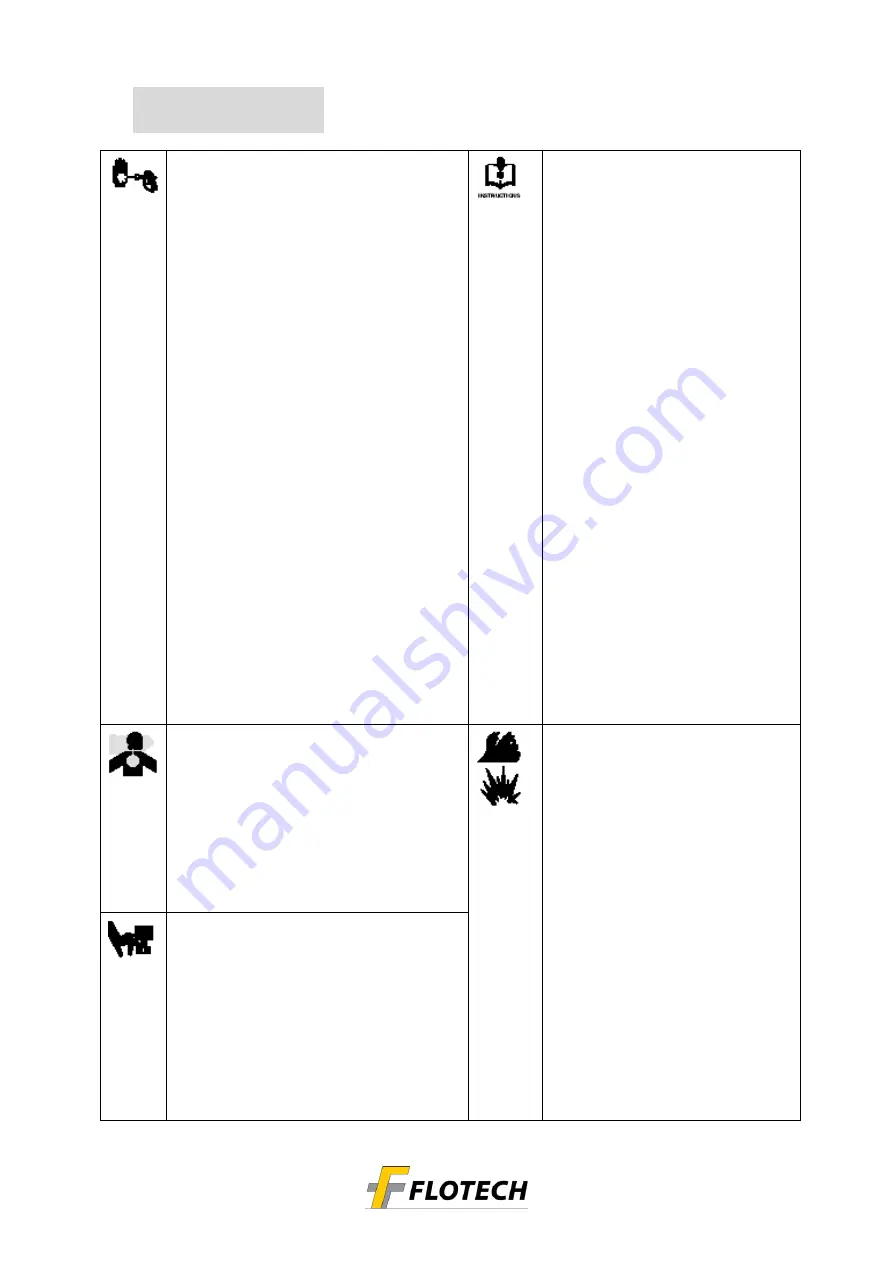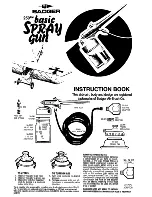
2
WARNING
INJECTION HAZARD
Spray from the spray gun, hose leaks or ruptured
components can inject fluid into your body and
cause extremely serious injury, including the need for
amputation. Splashing fluid in the eyes or on the
skin can also cause can also cause serious injury.
_
Fluid injected into the skin is a serious injury. The
injury may look like just a cut, but it is a serious
injury.
Get immediate medical attention.
_
Do not point the gun at anyone or any part of the
body.
_
Do not put hand or fingers over the spray tip.
_
Do not stop or deflect leaks with your hand, body,
glove or rag.
_
Do not “blow back” fluid; this is not an air spray
system.
_
Always have the tip guard on the spray gun when
spraying
_
Check the spray gun diffuser (if so equipped)
operation weekly. Refer to the gun manual.
_
Be sure the spray gun safety knob operates before
operating the gun.
_
Lock the spray gun safety knob when you stop
spraying.
_
Follow the
Pressure Relief Procedure
on page 3
when you are instructed to relieve pressure, stop
spraying, check, clean or service any system
equipment, or install or change spray tips.
_
Tighten all fluid connections before each use.
_
Check the hoses, tubes and couplings daily.
Replace worn or damaged parts immediately.
Permanently coupled hoses cannot be repaired.
_
Handle and route hoses and tubes carefully. Keep
hoses and tubes away from moving parts and
hot surfaces. Do not use the hoses to pull
equipment. Do not expose FLOTECH hoses to
temperatures
above 150
_
F (66
_
C) or below
–40
_
F (
–40
_
C).
EQUIPMENT MISUSE HAZARD
Equipment misuse can cause the equipment
to rupture, malfunction, or start
unexpectedly and result in serious injury.
_
This equipment is for professional use only.
_
Read all instruction manuals, tags, and
labels before operating the equipment.
_
Use the equipment only for its intended
purpose. If you are uncertain about the
usage, call your distributor.
_
Do not alter or modify this equipment. Use
only genuine FLOTECH parts and
accessories.
_
Check the equipment daily. Repair or
replace worn or damaged parts
immediately.
_
Do not exceed the maximum working
pressure of the lowest rated system
component. This equipment as a
5000 psi
(345bar) maximum working pressure.
_
Do not lift pressurized equipment.
_
Route the hoses away from the traffic
areas, sharp edges, moving parts, and hot
surfaces. Do not expose FLOTECH hoses
to temperatures above 150
_
F (66
_
C) or
below
–40
_
F (
–40
_
C).
_
Do not use the hoses to pull the equipment.
_
Use fluids or solvents that are compatible
with the equipment wetted parts. See the
Technical Data
section of all the
equipment manuals. Read the fluid and
solvent manufacturer’s warnings.
_
Fluid hoses must have spring guards on
both ends to protect them from rupture
caused by kinks or bends near the
couplings.
_
Comply with all applicable local, state and
national fire, electrical and other safety
regulations.
TOXIC FLUID HAZARD
Hazardous fluids or toxic fumes can cause a serious
injury or death if splashed in the eyes or on the
skin, inhaled, or swallowed.
_
Know the specific hazards of the fluid you are using.
_
Store hazardous fluid in an approved container.
Dispose hazardous fluid according to all local, state
and national guidelines.
_
Always wear protective eyewear, gloves, clothing
and recommended by the fluid and solvent
manufacturer.
FIRE AND EXPLOSION HAZARD
Improper grounding, poor air ventilation,
open flames, or sparks can cause a
hazardous condition and result in fire or
explosion and serious injury.
_
Ground the equipment and the object being
sprayed.
_
Provide fresh air ventilation to avoid the
buildup of flammable fumes from solvent
or the fluid being sprayed.
_
Extinguish all the open flames or pilot lights
in the spray area.
_
Electrically disconnect all the equipment in
the spray area.
_
Keep the spray area free of debris,
including solvent, rags, and gasoline.
_
Do not turn on or off any light switch in the
spray area while operating or if fumes are
present.
_
Do not smoke in the spray area.
_
Do not operate a gasoline engine in the
spray area.
_
If there is any static sparking while using
the equipment,
stop spraying
immediately
. Identify and correct the
problem.
MOVING PARTS HAZARD
Moving parts, such as the air motor piston and the
secondary pump lever and connecting rod area,
can pinch or amputate fingers.
_
Do not operate the equipment with the air motor
plates removed.
_
Keep your body and tools clear of any moving parts
when starting or operating the equipment.






















